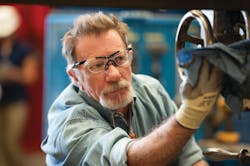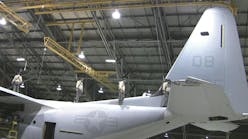In 1970, the Occupational Safety and Health Administration (OSHA) and the National Institute for Occupational Safety and Health (NIOSH) were created. Today, almost four decades after the implementations of the OSHA Act, a safe place to work is a requirement and an expectation. Yet, each year we still have an incredible number of workplace injuries and deaths. The numbers have been trending down but are still unacceptable. What is not understood is why worker fatalities are so high and why workers continue to injure themselves?
In Workplace Safety, James T. Burnette writes that several behavioral theories suggest that workers “may not care about the consequences; they could misperceive the risks or the consequences; or they might intentionally sabotage the safety policies and procedures.” Within any discussion of workplace safety, it’s important to consider the implications that generational shifts are having on the number and type of work-related injuries, as well as attitudes, work practices, and performance.
Kimberly-Clark Professional safety survey
In 2012, Kimberly-Clark Professional (KCP) conducted a survey of safety professionals to better understand the complicated issue of workplace injuries. Of those surveyed, “82 percent of the safety professionals said they had observed workers in their organizations failing to wear required personal protection equipment (PPE) during the past year. Even though it is mandated by OSHA, the vast majority of workers who have experienced on-the-job injuries were not wearing PPE.”
Some of the reasons respondents cited for not wearing their PPE were: “uncomfortable, too hot, blamed for decreased productivity or an inability to perform tasks, unavailable near the work task, ill-fitting, and unattractive looking.”
For further insight on workplace accidents and prevention, Aircraft Maintenance Technology Magazine reached out to safety expert Randy DeVaul, senior capability development manager, Global Industrial Safety for KCP. DeVaul has a doctorate in occupational safety and health, a master's degree in cross-cultural studies, is a commercial pilot ground instructor, and holds Commercial/Instrument Pilot, Airframe & Powerplant (A&P) mechanic, and multi-engine ratings.
AMT: Randy, thank you for taking time to help us better understand the complicated issue of workplace safety and some of the human factors that drive incidents. You have suggested that we need to consider the ages and attitudes of two key groups of workers. In so doing, safety professionals, company managers, and employee work groups can develop better safety solutions, resulting in higher acceptance and reduced risk or injury.
The work groups are: Generation Y (Gen Y) — defined as ages 15 to 30 years — which represent 14 percent of the U.S. labor force and are a high risk for workplace injuries; and Baby Boomers — defined as ages 49 to 67 years. Fatal work injury rates for workers 65 years of age and older was more than three times the rate for all workers.
AMT: What are the main challenges that the aviation industry is facing in terms of these generational differences?
Randy DeVaul: Many Baby Boomer aviation workers are able to retire but don’t necessarily want to retire. Those employees are working longer because they enjoy what they do or they have postponed retirement for various economic reasons. One in five people in the workplace are over the age of 55. By 2016, one-third of the total U.S. workforce will be age 50 or older, and the number of those workers will increase to 115 million by 2020.
Another factor is that many manufacturing jobs have moved out of the U.S., limiting the opportunity for Gen Y to develop an interest in, or work in, manufacturing or other heavy industries. Therefore, we have an aging workforce that isn’t wholly retiring and a skilled labor gap. In the aviation industry, this is creating challenges related to general safety, airplane safety, and worker quality of life.
AMT: What are the safety implications of the Baby Boomer generation continuing to work past the age of retirement?
Randy DeVaul: As part of its Safe-Skilled-Ready Workforce Initiative, NIOSH conducted research related to aging, shift work, and fatigue. One finding was that after a person consistently works a 10- to 12-hour shift, their response times become similar to a person who is legally drunk. When an older worker is doing shift work while fatigued, it can be a challenge for them to perform their tasks as efficiently and safely as they could 20 years earlier — especially when working in environments with exposure to hazards, lifting, carrying, and other injury triggers.
Injuries also tend to increase in severity, recovery time, and cost with critical older talent. This creates a quality of life challenge for the injured and their family and for their employer because an experienced worker is out on lost time and the employer incurs the expenses of that recovery. Recent estimates show that accident compensation amounted to more than $51.1 billion in direct costs annually for U.S. employers.
AMT: What are some of the differences in attitudes and behaviors between the two generations regarding workplace safety?
Randy DeVaul: In general, Gen Y is understood to be an entitlement generation that has grown up with everything being done for them or has the expectation that it will be. Part of that thinking carries over into the workplace. Employers are faced with a younger generation that is unskilled in certain tasks due to a lack of experience. These workers have the expectation that someone is watching out for them and may not understand the limitations of their PPE. Therefore, they may not take responsibility for their safety. Conversely, if Baby Boomers are injured, they feel that it is simply part of their job.
To them, it has always been this way. Because of this thinking, they may not be as careful as they could be when working. Gen Y is willing to wear PPE but expects someone to watch out for them, while Baby Boomers tend to not want to wear PPE and may even take shortcuts developed over time to make work easier.
AMT: What are some recommendations for addressing these differences in work practices, attitudes, and workplace safety solutions?
Randy DeVaul: Baby Boomers should be given more responsibility for transferring job knowledge so they are more directly engaged with Gen Y. Baby Boomers can be mentors, new-hire trainers, and help develop job-specific training videos. Aviation schools also should be more directly involved in creating safety training programs for entry-level AMTs.
One way KCP is working to address some of these challenges is by talking with and learning from front line aviation workers to develop innovative PPE. An example of these professional-derived safety solutions is the Jackson Safety V60 Safeview Safety Eyewear. Given that older workers often experience decreased visual acuity, which includes having a harder time reading small print or discerning colors and signage that identifies hazards, this new safety eyewear features close-fit prescription Rx lens inserts that can be easily clipped behind an eye shield.
Ideal for corrective lens wearers or workers that require close-up magnification, the glasses help to reduce eye fatigue or strain so workers do not compromise on safety, performance, or comfort. In combination with these efforts, KCP is also developing training and mentoring programs that will help bridge the gap between the Baby Boomers and Gen Y aviation professionals.
AMT thanks safety expert Randy DeVaul for providing some insight and helping us better understand the many dimensions of workplace safety.
Each year employers, workers and society pay the tremendous costs for workers’ insurance, medical expenses, lost wages, and productivity associated with workplace illnesses, injuries, and deaths. We, the workers, must accept the responsibility for following safety precautions and wear the required PPEs necessary to keep us safe. It will always be us, not the agencies or corporations that will endure the pain and suffering, psychological and family stress, lifestyle adjustments, and career-shortening implications associated with these workplace injuries.
Field Editor Charles Chandler began his aviation career as a junior mechanic for American Airlines and retired after 27 years of service. After leaving American he held both line and staff positions in six other major companies. His positions with those companies included curriculum development specialist, manager and director for organizational development, management and leadership development, and maintenance training operations departments. He has a Masters of Science Degree in Adult and Occupational Education with a major in Human Resources Development.




